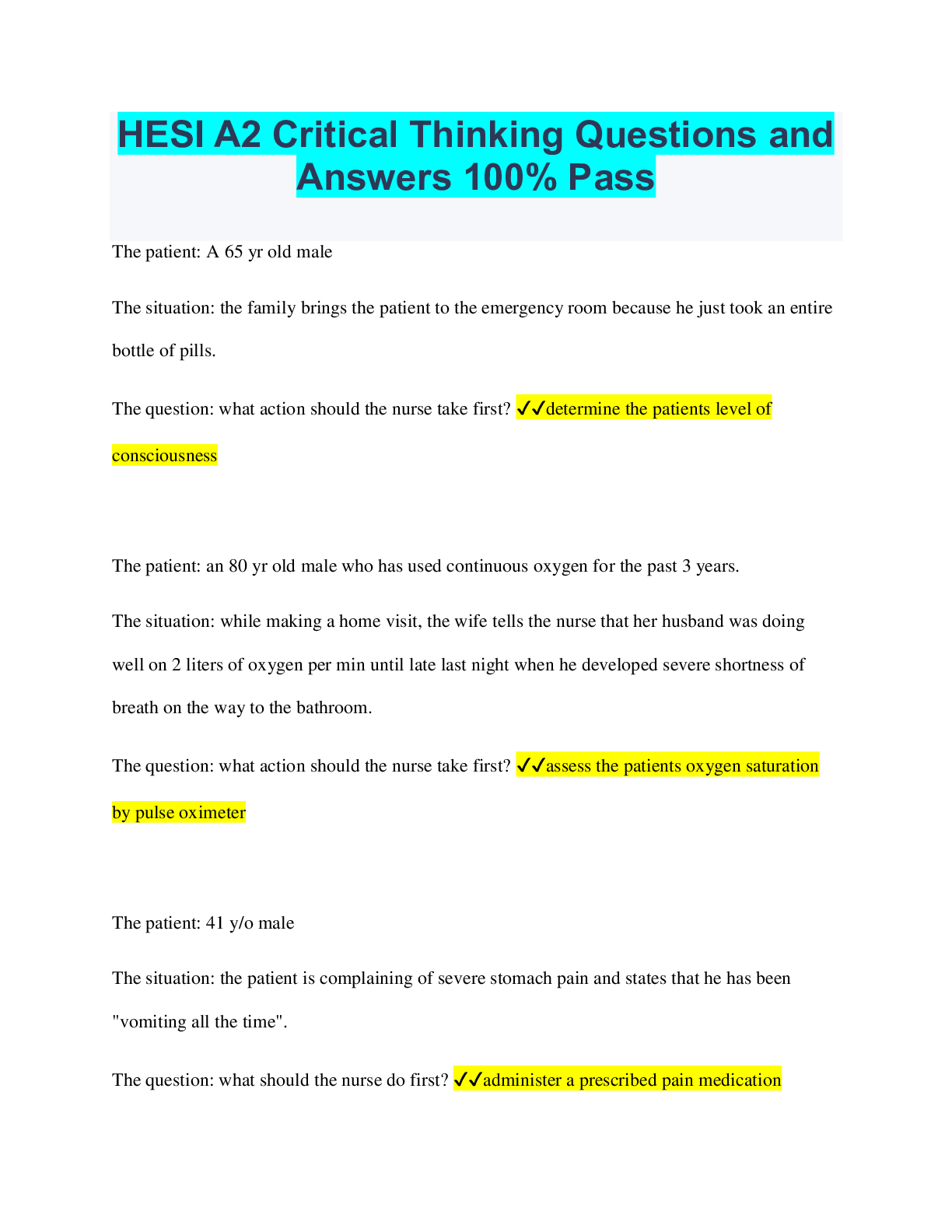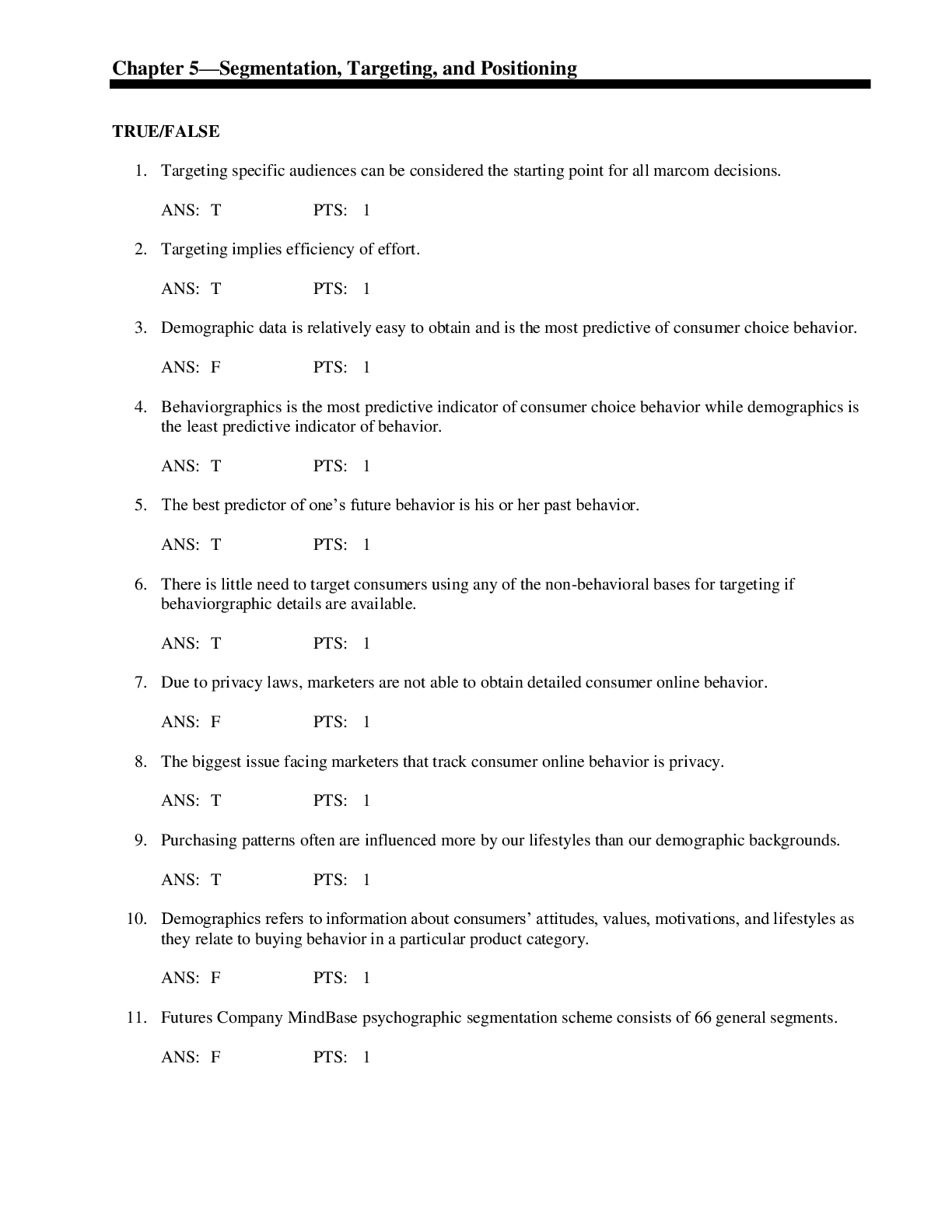Biology > QUESTIONS & ANSWERS > Chapter 9: The Endocrine System Questions and Answers Already Passed (All)
Chapter 9: The Endocrine System Questions and Answers Already Passed
Document Content and Description Below
Chapter 9: The Endocrine System Questions and Answers Already Passed Explain how the nervous and endocrine systems differ in (a) the rate of their control, (b) the way in which they communicate wit... h body cells, and (c) the types of body processes they control. ✔✔a. The nervous system is instantaneous, while the endocrine system takes a few minutes. b. The nervous system connects directly to target cells and organs, while the endocrine system uses hormones and chemical signals to send messages to target cells and organs. c. The nervous system controls muscle contraction, automatic responses, and voluntary actions, while the endocrine system uses hormones that can change permeability of cell membranes, activate or deactivate enzymes, or stimulate mitosis. Provide one example for each way endocrine glands are stimulated to release their hormones. ✔✔-Hormonal: hypothalamic hormones stimulate the anterior pituitary gland and other to release hormones. -Hormonal Stimuli: parathyroid hormones are prompted by decreasing blood calcium levels. -Neural Stimuli: sympathetic nervous system triggers adrenal glands. Define negative feedback ✔✔a system of feedback that causes the stimulus to decline or end. Explain why not all organs are target organs for all hormones. ✔✔Target organs will have specialized receptors on it for that particular hormone. Other cells in other organs won't have those receptors. Describe the body location of each of the following endocrine organs: anterior pitituary, pineal gland, thymus, pancreas ovaries, testes. Then, for each organ, name its hormones and their effect(s) on body processes. Finally for each hormone, list the importatn results of its hypersection or hyposecretion. ✔✔*Anterior pituitary: Protrudes from the inferior surface of the brain, incased in the sella turcica of the sphenoid bone. Produces: -A) Growth Hormone(GH) which causes overall body growth but particulary skeletal & muscualar growth. A lack during childhood leads to pituitary dwarfism. Oversecretion produces giganticism (kids) or acromegaly (adult). -B) Prolactin (PRL) which stimulates lactation in females. An excess leads to inappropriate lactation. -C) Gonadotropic hormones LSH adn LH, which stimulate the production of ova/estrogen/progesterone in females and sperm/testosterone in males. A lack results in sterility. Overproduction of FSH leads to understimulation of adrenal cortex hormones. For LH, hypersecretion also leads to infertility & miscarriage in women D) TSH, which stimulates the production of thyroxin by the thyroid gland. A lack results in hypothyroidism (cretinism in kids, myxedema in adults). TSH hypersecretion to cause disease is rare. Can lead to increased metabolism. E) ACTH, which regulates the activity of the adrenal cortex. Hypersecretion results in Cushing's Syndrome. Hyposecretion results in Addisons disease. *Posterior Pituitary: Releases 2 hormones made by the hypothalamus, ADH & oxytocin. A lack of ADH leads to insipidus, while oversecretion leads to hyponatremia or low blood sodium concentration. For oxytocin, hyposecretion leads to failure to progress in labor contractions as well as difficulty in milk let-down, while hyper secretion isn't commonly observed, but can lead to suppression of ACTH. *Pineal Gland: Found at the superioposterior end of the 3rd ventricle in the brain. the pineal gland release melatonin, which is important for regulating sleep& wake cycles and inhibits precocious sexual development in humans.Early hyposecretion results in sexual maturity earlier than normal, while hyposecretion can lead to depression & sleepiness. *Thymus: Found in the anterior thorax, overlying the trachea and heart. Its hormone, thymosine, serves to program the T-lymphocytes of the immune system for recognition of self from nonself. Athymic individs lack the ability to mount an effective imunne response. Hypersecretion isn't observed. *Pancrease: Located in the abdomen, in the mesentery btw the stomach & duodenum. Produces, insulin, (basically a hypoglycemic hormone that promotes the uptake & metabolism of glucose by body cells. lack of insulin leads to diabetes mellitus. Hypersecretion may lead to hypoglycemia or 'insulin shock'.) Glucagon (basically a hyperglycemic that promotes the release of glucose by liver when blood glucose levels are low. NO documented hypersecretion or hyposecretion problems. *Ovaries: Located in abdominopelvic cavity, lateral to uterus. Produces estrogen & progesterone. Lack of these hormone leads to inability to conceive kids & reduced development of secondary female characteristics. Hypersecretion can lead to premature sexual development in females & infertility. *Testes: Located in the scotal sac, medial to the superior thighs. Produces testosterone, a lack of which leads to a reduction in sperm count & reduced development of secondary male characteristics. Hypersecretion can lead to premature sexual development in males & muscle hypertrophy. The anterior pituitary is often referred to as the master endocrine gland, but it too has a "master". what controls the release of hormones by the anterior pituitary? ✔✔Is controlled by the hypothalamus but through hormonal stimulation. the releasing hormones of the hypothalamus controls anterior pituitary hormone release (in addition to feedback inhibition). What's the most common cause of hypersecretion by endocrine glands? ✔✔a tumor What causes simple goiter? ✔✔A goiter is a enlarged thyroid gland that usually results from lack of iodine in the diet. As we age the endocrine system become less effecient. List examples of problems elderly people face w/age. ✔✔-Menopause: In women they experience hot flashes and become susceptable to osteoporosis & arteriosclerosis -Men& women: become increasingly hyperthyroid with age. They also become more susceptable to adult onstage diabetes as pancreatic function decreases. -Growth hormone decline leads to atrophy of muscles.Theres a dysregulation of antistress hormone that lowers resistence to infectous disease. A woman with excessive body hair & a deep voice shows the outward symptoms of which hormonal dysfunction? ✔✔The dysfunction is hyposecretion of adrogens (testosterone), possibly from a tumor of the adrenal cortex. Parents worry about weight of 14yr old (4ft tall), parent both 6ft. Diagnostic test determined that certain hormones are prescribed to the kid. Whats the diagnosis? What hormones are prescribed? ✔✔-Diagnosis: Hyporsecretion of growth hormone. -Prescription: Is commercial pituitary growth hormone. -the girl might reach her growth potential bcuz the epiphyseal plates of her bones haven't closed yet, allowing additional growth of the skeleton& body, in response to the hormone. Paula (28yr) has been in labor for 15hrs. She has weak uterine contractions and her labor isn't progressing normally. the Dr orders Pitocin (a synthetic oxytocin). Whats the affect of this hormone? ✔✔-Pitocin: Works exactly like oxytocin to stimulate the contraction of smooth muscle of the myometrium, thus strengtheining her contractions to expel the baby. What are the possible harmful effects of using anabolic steroids to increase muscle mass & strength? ✔✔Bloated face (sign of steroid excess), shrivled testes and infertility, liver damage, liver cancer and possible increase in risk of coronary heart disease & psychiatric problems. Bertha (40 yr old) go to clinic with swelling in her face and unusual fat deposit on her back and abdomen. She reports bruising easily. Blood test= elevated glucose levels. What her diagnosis? ✔✔-Diagnosis: Cushing's Syndrome-Hypersecretion of glucocorticoids from the middle region of the adrenal cortex. Richard had sympotoms of excessive secretion of PTH (high blood calcium levels), and his Dr was certain he had a pituitary tumor. The surgeons couldn't find his parathyroid. Where should the surgeon look next to find the tumorous parathyroid gland? ✔✔They should look on the posterior (dorsal) surface of the thyroid gland. target cells ✔✔cells that have receptors for a particular hormone second messenger ✔✔Intracellular molecule generated by the binding of a chemical (hormone or neurotransmitter) to a receptor protein; mediates intracellular responses to the chemical messenger. Oxytocin ✔✔A hormone released by the posterior pituitary that stimulates uterine contractions during childbirth and milk ejection during breastfeeding. ductless glands ✔✔endocrine glands that produce hormones that they release into the blood or lymph Vasopressin ✔✔a hormone that can treat diabetes insipidus. It is also used after stomach surgery or before stomach x-rays. In addition it can also increase blood pressure in patients with vasodilatory shock. tropic hormones ✔✔a hormone that regulates the function of another endocrine organ Gigantism ✔✔a condition produced by hypersecretion of growth hormone during the early years of life Prolactin ✔✔a hormone released from the anterior pituitary gland that stimulates milk production after childbirth. Lutenizing Hormone (LH) ✔✔gonadotropic hormone released by the anterior pituitary gland sterility ✔✔inability to produce offspring follicle ✔✔-a structure in an ovary consisting of a developing egg surrounded by follicle cells. -colloid-containing structure in the thyroid gland. myxedema ✔✔caused by extreme deficiency of thyroid secretion; also known as adult hypothyroidism Calcitonin ✔✔a hormone secreted by the thyroid gland that reduces the concentration of blood calcium level when it has risen to an above normal level Thymosin ✔✔he hormone of the thymus, and it stimulates the development of disease-fighting T cells Androgens ✔✔male sex hormones pineal gland ✔✔secretes melatonin; located in the epithalamus thyroid gland ✔✔produces hormones that regulate metabolism, body heat, and bone growth; located around the trachea Hypothalamus ✔✔the region of the diencephalon forming the floor of the third ventricle of the brain. controls body temperature, thirst, hunger, and other homeostatic systems, and involved in sleep and emotional activity. Relaxin ✔✔The hormone that increases the flexibility of the pubic symphysis during pregnancy is [Show More]
Last updated: 2 years ago
Preview 1 out of 10 pages
.png)
Buy this document to get the full access instantly
Instant Download Access after purchase
Buy NowInstant download
We Accept:

Also available in bundle (1)
.png)
Endocrine System Bundled Exams Compilation Tests
Endocrine System Bundled Exams Compilation Tests
By Nutmegs 2 years ago
$20
14
Reviews( 0 )
$10.00
Can't find what you want? Try our AI powered Search
Document information
Connected school, study & course
About the document
Uploaded On
Feb 20, 2023
Number of pages
10
Written in
Additional information
This document has been written for:
Uploaded
Feb 20, 2023
Downloads
0
Views
110


























